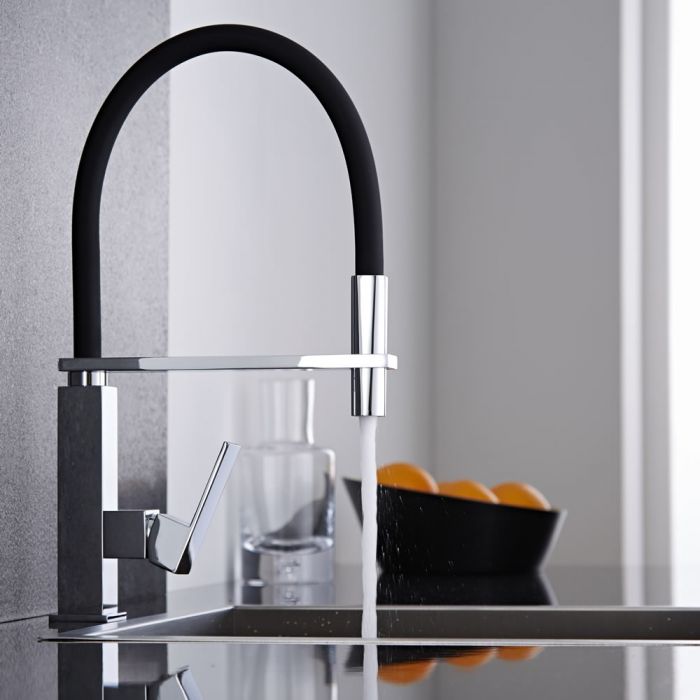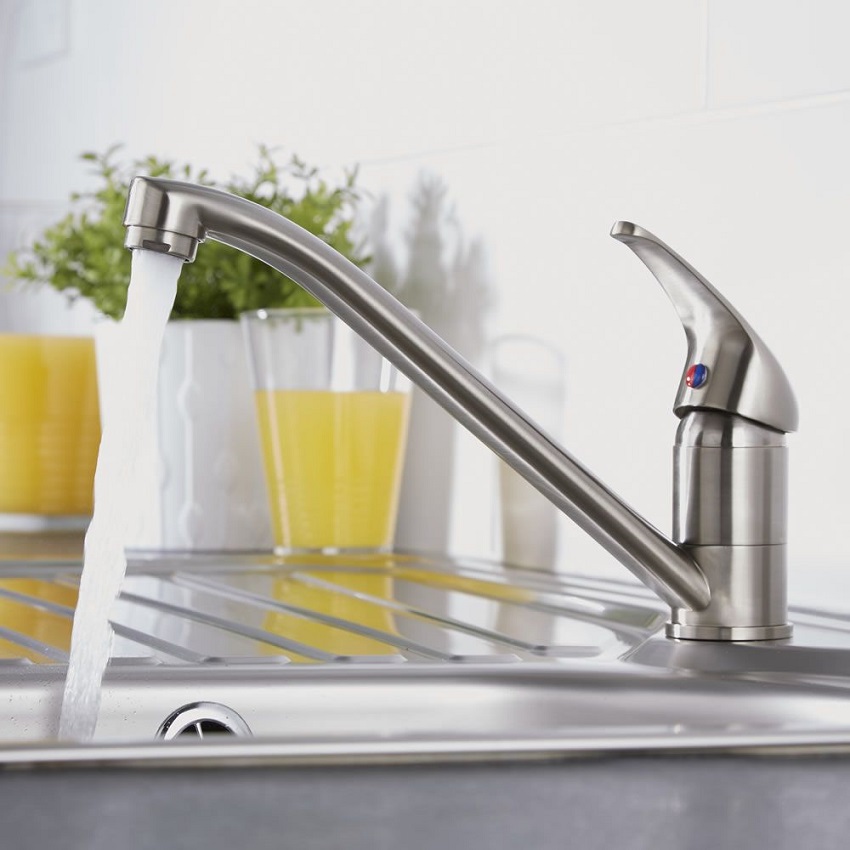Whether your kitchen tap is not working properly, or you just want to refresh and update your kitchen with a new one, replacing a kitchen tap is a straightforward job with the right tools and a little planning. Our expert DIY guide explains how to install a monobloc sink tap.
Before changing a kitchen tap, you will need to choose the right type to suit your kitchen sink. You could replace your existing kitchen sink taps with something similar, or you could create a fresh new look with something completely different. Kitchen taps come in a wide range of styles and finishes to enhance any décor. Make sure to choose the best one with the help of our kitchen tap buyer’s guide.

How to change a kitchen tap
You will need:
- Masking tape
- Flexible hoses
- Compression fit check valves (if required)
- PTFE tape and thread seal tape
- Bucket
- Slotted screwdriver
- x2 250mm adjustable wrenches
- Water pump pliers
- Basin wrench
- 15mm pipe cutter
- Box spanner
- Olive splitter or junior hacksaw
How to remove the old kitchen tap
- Turn off the water supply before starting any work.
- If the pipes supplying the existing pipes have isolating valves you will need to switch the hot and cold water off by turning the screw heads with a slotted screwdriver, so they are at a right angle. Once you’ve done that, run the kitchen tap to drain the water from the pipes.
- If the pipes don’t have isolating valves, you will need to turn the water off at the mains by closing the stopcock. Turn the cold tap on and run until the water storage tank and pipes are empty. Turn the tap off when the system has drained.
- Make sure there’s enough room to work under the sink and place an old towel down to catch any spills. It’s also a good idea to position a bucket to catch drips.
- Disconnect the water pipes. If the old tap has been fitted with compression fittings use two adjustable wrenches to undo the nuts. You will need to hold and support the fitting with one wrench and use the other one to loosen the nut on the tap side of the fitting.
- Unscrew the loosened nut with your fingers. You can then remove the copper/brass olive from each of the tap connection pipes with water pump pliers (the olive is the part that makes the seal between the pipe and the fitting). Use an olive splitter or a junior hacksaw if the olive is jammed.
- When the pipes have been disconnected, use a box spanner to undo the brass nut that secures the tap in position. The old tap can then be removed from the sink.
- Finally, clean the area where the old kitchen tap was.
How to fit the new kitchen tap
- Assemble and fit any required parts to the tap by following the instructions in the box.
- Attach the flexible tap connectors by screwing them into the base of the tap.
- Position the tap into the sink hole. Place the correct seal between the tap and sink. Make sure the hot and cold connectors are the right way round and not twisted when putting them through the hole. (When fitting taps, the hot should be on the left and the cold on the right).
- You can then secure the kitchen tap from underneath. Under the sink, place the washer on first, followed by the securing plate. Tighten in position with the locking nut using a box spanner.
- Use the adjustable wrenches to connect the hot and cold-water pipes. Hold and support the valve fitting with one wrench and use the other to tighten the nut on the top side of the isolation valve.
- If the existing pipework doesn’t line up with the new tap, you can use flexible tap connectors to join the tap with the pipework.
- Once the tap has been installed, check the joints are tight and switch the water supply back on. Turn the cold supply on first, and partly open the isolation valve or stopcock to start with to check for any leaks. If there are no leaks, you can fully open the valves.
- If the compression joint is leaking, you may need to undo the joint and wrap PTFE tape around the olive. Wrap the tape in the opposite direction to the thread on the pipe.
- Once you are happy with the connections, you can then test the new tap and double check under the sink for any leaks.
John has a background in sports journalism, and lists content writing amongst his primary passions. He provides expert bathroom trends commentary and analysis, as well as offering meticulously researched answers to the most frequently asked bathroom posers.




